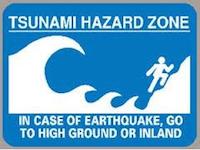 This January was the tenth anniversary of the Asian Boxing Day tsunami. This devastating disaster generated a huge outpouring of generosity from people around the world. Kiwis too dug deep and contributed to many aid programmes.
This January was the tenth anniversary of the Asian Boxing Day tsunami. This devastating disaster generated a huge outpouring of generosity from people around the world. Kiwis too dug deep and contributed to many aid programmes.
Sri Lanka, a tear shaped island, was one of the worst hit with 40,000 deaths. Three years after the tsunami I was privileged to travel there on a Teacher Fellowship for two weeks to see how the $42,000 raised by Operation Phoenix North Shore had been spent.
Operation Phoenix North Shore was a small but enthusiastic team based at North Shore City Council and led by wastewater engineer Dave Woods. They had partnered with Sarvodaya, Sri Lanka’s largest charity, to build 6 houses in Thalpitiya village on the coast south of Colombo. The tsunami fortunately did not claim many lives there, but left 46 houses destroyed.
At the time Sri Lanka was still embroiled in a civil war. I stayed in a little local resort close to the village that was mainly used by the military. Young soldiers were spending precious time with their loved ones before heading back into the war zone. Weddings were a frequent event and I was invited to watch a traditional bridal ceremony performed on a decorated dais and a performance by brilliantly costumed Kandyan drummers and dancers.
My days were spent in the village. Sarvodaya had done a wonderful job. The new houses were small but solidly built and fully furnished. They were much better than many of the other houses in the village. Unlike in New Zealand it is poor people who live close to the sea in Sri Lanka.
It felt quite emotional to see plaques saying donated by North Shore City placed on the front of these houses and seeing how the money which had been raised there` had provided people who had lost everything with a new roof over their heads.
They welcomed me with drinks and fruit and proudly showed me around. Although extremely grateful they were still traumatised and scared that a killer wave could come again.
Back at the resort at night I would lie awake listening to the sound of the waves crashing on the shore and shared their fear.
One day the brother of one of the Sri Lankan members of Operation Phoenix North Shore kindly took me out for the day. We visited the Pinnawala elephant orphanage and watched the elephants being bathed in the river. To quench our thirst in the heat of the day we bought King Coconuts from a roadside stall and drank the juice, which is highly refreshing. Later we stopped off in a garden café to drink fragrant tea and snack on delicious jaggery and coconut-flavoured sweetmeats.
At Hakkudiwa station we saw the remains of a train that had been swept away by the tsunami. It had been left as a tragic memorial to the thousands of passengers that were killed, the highest number of deaths in railroad history.
In picturesque Galle we walked on the cobbled streets in the old quarter, admiring the old buildings. The centuries old ramparts built by the Dutch had protected it from the tsunami but the killer wave swept over the newer parts of the town including the cricket ground and the nearby bus station .In all more than 4000 people in Galle lost their lives.
The debris left by the tsunami had largely been cleared but the number of tourists was still small. They hoped they would return soon as the tourist dollar is such an important part of people’s livelihoods here.
I’d love to go back and spend more time in Sri Lanka although I found the humidity and the heat a challenge. It’s a fascinating country with many places of scenic beauty and historical interest.
I know it is most unlikely that a tsunami would strike in the same place again. But having met people who were directly affected by it has made me aware that if you holiday in a tsunami prone zone (and this includes all the coastal areas New Zealand and many other parts of the world) you should find out what tsunami warning systems are in place. These could include sirens on beaches or messages on your mobile. For instance Aucklanders can download the free ‘Auckland Civil Defence’ app on any smartphone, including iPhone, Android and Windows devices.
And be aware that a tsunami can happen so quickly and unexpectedly that you may have to fend for yourself as best you can. If you know the natural warning signs that will give you a better chance of survival. They are spelt out in the NZ Government disaster site
If you are at the coast, you should immediately move to the nearest high ground or as far inland as you can if you
– feel a strong earthquake that makes it hard to stand up, or
– a weak rolling earthquake that lasts a minute or more
– see a sudden rise or fall in sea level
– hear loud or unusual noises from the sea.









Join the Discussion
Type out your comment here:
You must be logged in to post a comment.